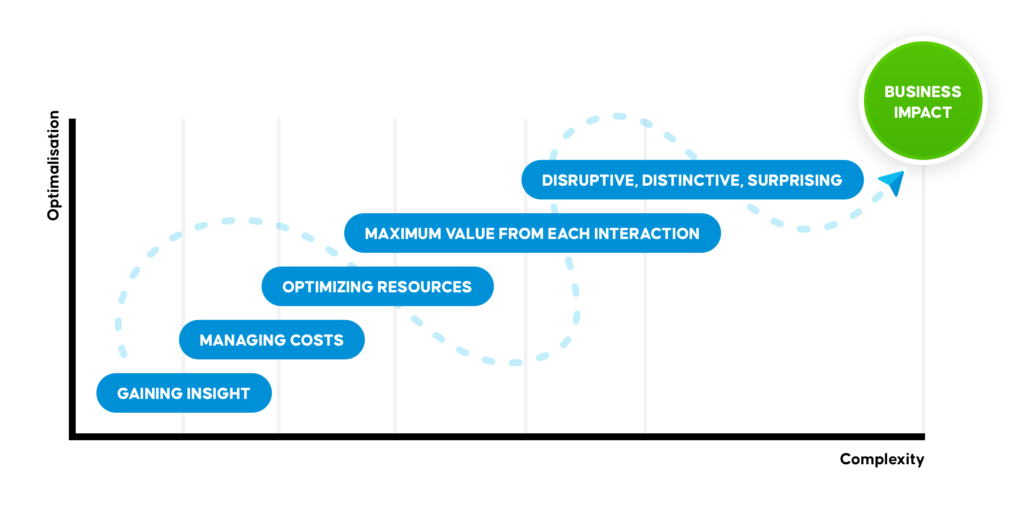The Service Management Hike
Creating a high-quality service process from scratch, including the perfect customer experience, is virtually impossible. Do you want your service processes to have greater impact on your company’s results? Then you need to keep developing your processes and allow them mature. This development takes place in steps. Your next step depends on where your organisation is today. In a series of blogs, we will be guiding you through the various steps of the ‘Service Management Hike’. Which challenges might you expect? How do other organisations deal with them? And how can you take the next step yourself?
Five steps
Every service management journey consists of several phases, each presenting its own challenges and questions. These phases can be divided into five so-called maturity levels. Five steps you take to improve your service management.
1. Gaining insight
2. Managing costs
3. Optimizing Resources
4. Maximum value from each interaction
5. Disruptive, distinctive, surprising

Step 1: Gaining insight
The first step is ‘gaining insight’. In this phase, your organisation will still be working on paper to a considerable extent. Information about the service process may not have been centralised yet. You’re trying to obtain a clear picture of the service process and looking for answers to the following questions:
- Which service activities do we perform and for whom?
- Who are our (service) customers and what are their needs?
- Which products have we sold so far, how are these performing and/or what condition are they in?
- Exactly what has a technician done for the customer? How much time did they spend doing this?
- How many spare parts of type X do we have in stock?
Step 2: Managing costs
You have a clear picture of your processes; paper flows have all been digitized and all service information is centrally available. Now you are ready to use this foundation to control costs. In phase two, you can find out what the costs of providing a certain service have been. Questions that arise here include:
- What cost (time and material) have we incurred as a service organisation under contract X?
- What are the average costs of asset Y over the product life cycle?
- What cost did we incur to solve the customer’s problem from A to Z?
Step 3: Optimizing resources
The third step is ‘optimizing resources’. It is important that you get the right people to the right location at the agreed time, with the necessary equipment. In the most efficient way possible, of course. To achieve this, you’ll need to answer the following questions:
- How do I ensure the customer is being helped by the most suitable service employee?
- How do I ensure good distribution of cases among customer contact employees?
- How can I centralize knowledge so that the service organisation can make good use of it?
- How do I ensure the right engineer is in the right place with the right equipment at the right time?
- How do I ensure technicians need to travel as little as possible?
- How do I ensure agreements are kept?
Step 4: Maximum value from each interaction
Once you reach the fourth maturity level, you obtain the ‘maximum value from every interaction’. Interaction with your customers is central to this phase. Keep this in mind when you answer the questions below:
- How can I involve the customer in the service process?
- How do I build a relationship with the customer and increase loyalty?
- How can I help the customer further, directly, without a technician visit?
- How do I capitalize on most up- and cross-sell opportunities?
Step 5: Disruptive, distinctive, surprising
In concluding the service management journey, aim as high as possible. The fifth and final step concerns the creation of distinctiveness. Ask yourself what you can do to disrupt, differentiate and/or surprise:
- How can I go the extra mile for the customer?
- How can we help the customer with any issues they haven’t mentioned yet?
- How can I get my customers to talk positively about our services outside of work?
Improve your service management: we’re right beside you!
BlueHike is a Field Service Management specialist. We’ve already done the fieldwork for you, so your service management journey can run as smoothly as possible. Embarking on your first service management journey? Then read the next blog ‘Gain insight in your service process’. Also worth reading if you’ve been on that road for a while.






